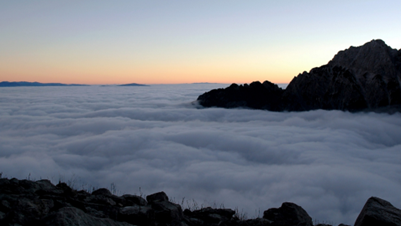You are reading the continuation of the article Fyzika atmosféry, meteorologie a bezpečnost (1). The physics of the atmosphere is described primarily by meteorology, i.e. the science of the Earth’s atmosphere, its composition, properties, phenomena and processes occurring in it. It uses mainly physical knowledge and methods of solution, referred to as atmospheric physics.
Resources used:
Klima skripta. Gisáci na UPOL: GIS GEOINFORMATIKA A ROMANTIKA [online]. Olomouc: MarijaStudio, 2007 [cit. 2017-09-03]. Dostupné z: http://www.gisaci.upol.cz/filesftp/Klima_skripta.pdf
NEČAS, Tomáš. Fyzika v atmosféře aneb základy meteorologie: Modulární systém dalšího vzdělávání pedagogických pracovníků JmK v přírodních vědách a informatice CZ.1.07/1.3.10/02.0024. Brno: Přírodovědecká fakulta, Masarykova univerzita v Brně, 2011. Dostupné z: http://ucitele.sci.muni.cz/materialy/94_1.pdf
SKŘEHOT, Petr. Atmosférické optické jevy. Meteorologická Optická Rada. [Online 3. 9. 2017]. Dostupné z: www.astronomie.cz/download/atmosfericke-opticke-jevy.pdf
Airflow as a physical phenomenon
One of the basic features of the Earth’s atmosphere is the constant movement and displacement of different volumes of air. The atmosphere tends to balance these differences and the manifestation of this is airflow. The orientation of the flow direction is always from a region of higher to a region of lower air pressure. There is a transfer of material particles but also of heat energy. We understand the term flow as disordered motion, although in the atmosphere we can also encounter orderly flow1 Klima skripta. Gisáci na UPOL: GIS GEOINFORMATIKA A ROMANTIKA [online]. Olomouc: MarijaStudio, 2007 [cit. 2017-09-03]. Dostupné z: http://www.gisaci.upol.cz/filesftp/Klima_skripta.pdf:
Laminar flow – a form of flow without turbulent eddy motions formed over an aerodynamically smooth surface. Air particles move parallel to the direction of flow. It occurs only in a thin layer over an aerodynamically smooth surface. It is extremely rare, and does not occur in flow over aerodynamically rough surfaces (vegetation, built-up area,…).
Catabatic flow – downward sliding movement of cold air, e.g. along a sloping georelief.
Anabatic flow – outward sliding flow along a dipping georelief. Anabatic character is also the outward flow of warm air on anafronts.
Convection – outward flow caused by horizontal inhomogeneity of the atmosphere. A necessary prerequisite for development is overheating of the active surface associated with an increase in the baric degree. If convection is realized in a closed ring it is a convection cell. This characterises ordered convection. A distinction is made between thermal convection (thermal turbulence used in sport aviation) and forced convection (mechanical) – with the contribution of an initial impulse of flow through an orographic obstacle.
Subsidence – slow, descending, subsiding movements within an air mass. Causes adiabatic warming of the air and dissolves the resulting cloud cover.
Turbulence – the most common, the essence in irregular and disordered vortex movements. Furthermore, vertical elevation and roughness of the georelief. Develops from laminar flow when critical velocity is exceeded. The degree of turbulence is determined by the nature of the thermal stratification of the atmosphere. Turbulence in the atmosphere is associated with gusts, winds, and acts to mix air and transfer heat, water vapour and air pollutants.
Eddies – formed mechanically (roughness of relief) = orographic turbulence or as a result of instability of temperature stratification of the atmosphere – thermal = convective or storm turbulence.
Advection – the transfer of a volume of air by a current in the atmosphere.
Causes of motion – the causes of motion are the force of the horizontal pressure gradient, the Coriolis force (by the earth’s rotation, the turning of masses to the S to the right and to the S to the left – see figure 39), the force of friction (against the direction of motion). “The wind, which contains the predominant horizontal component of air motion, can be expressed by the vector v and is characterized by direction and velocity” – formula see source2 Klima skripta. Gisáci na UPOL: GIS GEOINFORMATIKA A ROMANTIKA [online]. Olomouc: MarijaStudio, 2007 [cit. 2017-09-03]. Dostupné z: http://www.gisaci.upol.cz/filesftp/Klima_skripta.pdf.
Geostrophic wind – the simplest air movement, ideal horizontal uniform straight-line flow without friction. If we stand with our backs to the wind, TN is on the left in front, TV is on the right behind.
Cyclones -phases – front, wave, young cyclone, occlusion, dying cyclone.
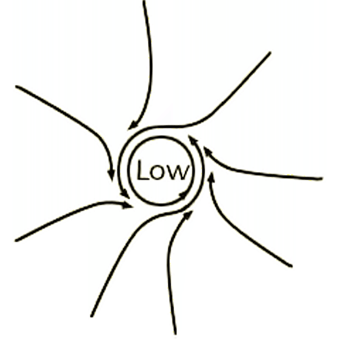
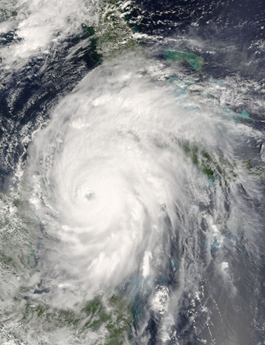
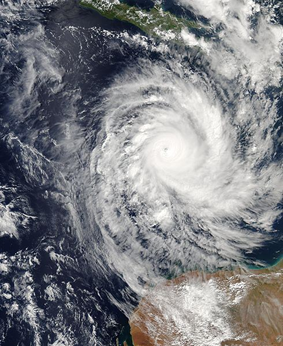
Wind speed – measured in m.s -1 , max. Mt. Washington 416 km/h. Winds of more than 5 m/s are gusty.
Wind direction – north wind is from the north. If the change is greater than 45° it is a variable wind.
Beaufort scale 13 degrees:
0 – no wind 1 km/h,
1 – breeze,
2 to 8 – light to gale force winds,
9 to 11 – gale,
12, hurricane > 118 km/h.
Daily running speed – max is around 2pm, min is at night or in the morning. Direction for northern hemisphere – increasing speed in the morning and turning right, decreasing after noon and turning left.
Atmospheric circulation systems
The circulation of the atmosphere is always accompanied by the transfer of energy, momentum and water. Basic types: jet stream, air circulation in cyclonic and anticyclonic systems, trade wind and monsoon circulation. Mesoscale circulations – gales, squalls, breezes, mountain and valley winds 3Klima skripta. Gisáci na UPOL: GIS GEOINFORMATIKA A ROMANTIKA [online]. Olomouc: MarijaStudio, 2007 [cit. 2017-09-03]. Dostupné z: http://www.gisaci.upol.cz/filesftp/Klima_skripta.pdf..
Circulation by source4Klima skripta. Gisáci na UPOL: GIS GEOINFORMATIKA A ROMANTIKA [online]. Olomouc: MarijaStudio, 2007 [cit. 2017-09-03]. Dostupné z: http://www.gisaci.upol.cz/filesftp/Klima_skripta.pdf. affect:
Radiant energy of the Sun – the uneven distribution of radiant energy is one of the main drivers of circulation.
Rotational motion of the Earth – due to the Coriolis force, at the equator=0, at the poles the most.
Inhomogeneity of the Earth’s surface – affects the air temperature and is manifested throughout the troposphere due to turbulent mixing.
Friction of air on the earth’s surface – it is a decrease in speed and change of direction, only up to heights of about 1.5 km.
If the Earth did not rotate and had a flat surface, this would be ideal – warm air from the equator to the poles – cooling and back to the equator. Around the equator a tropical zone of stillness = tropical convergence zone = NT, trade winds in the northern hemisphere NE, in the southern hemisphere SE. Tropical cyclones represent disturbances in the atmosphere at low latitudes. They differ from non-tropical ones by their smaller size, low pressure values at their centres and high velocities. Air vortices with a maximum diameter of several hundred km. Their motions follow the direction of the trade winds. They always form over the ocean and in the Pacific. The source is the surface water of tropical oceans with a temperature of more than 26°C. Tropical cyclones by location – hurricane or hurricane – Wed. Am., typhoon – Far E, hurricane – S Indian Ocean, cyclone – Bay of Bengal, Willy-Willies – between Australia and Cocos Oves5Klima skripta. Gisáci na UPOL: GIS GEOINFORMATIKA A ROMANTIKA [online]. Olomouc: MarijaStudio, 2007 [cit. 2017-09-03]. Dostupné z: http://www.gisaci.upol.cz/filesftp/Klima_skripta.pdf..
3 basic types of atmospheric circulation according to the source 6Klima skripta. Gisáci na UPOL: GIS GEOINFORMATIKA A ROMANTIKA [online]. Olomouc: MarijaStudio, 2007 [cit. 2017-09-03]. Dostupné z: http://www.gisaci.upol.cz/filesftp/Klima_skripta.pdf.:
- Zonal circulation – along the parallels, for W and W. E influx of warm and moist air from the Atlantic in winter and cool moist air in summer. Determinant of the great circulation of water.
- Meridional – meridians, cold C and warm A, allows the intrusion of cold air from the Arctic and warm air from the subtropics into E.
- Mixed – both.
Local circulation winds with different characteristics: breezes, valley and mountain winds, glacial winds, blowing winds, bores, small-scale air eddies – hail, trombs, tornadoes, urban winds.
Monsoons – uneven heating of land and oceans.
El-Niño – this phenomenon is the best known manifestation of a disturbance in the general circulation of the atmosphere. The translation means “Little Jesus” it by the fact that it regularly occurs at Christmas time. It occurs after a period of increased trade winds, which in equatorial regions leads to the westward displacement of increased sea water. In the direction of the regular currents. When the trade winds weaken, the accumulated water flows back. This is manifested by the disappearance of the cold Peruvian Current along the west coast of J Am. Off the coasts of Peru, Ecuador and Colombia there is an increase in water temperature (1983 by 11°C)! and a rise of several cm. Consequences: torrential rains, impact on fauna and flora, fish kills due to lack of food – impact on local fishermen. El-Niño is also accompanied by pressure changes – ENSO – El-Niño Southern Oscillations. Change in the general circulation of the atmosphere. This anomaly has been shown to affect other phenomena – droughts in equatorial Africa, flooding in the Mississippi basin,… (generally threatening bird life, coral rifts, forest fires, marine life, coastal erosion, droughts, floods and tropical storms)7Klima skripta. Gisáci na UPOL: GIS GEOINFORMATIKA A ROMANTIKA [online]. Olomouc: MarijaStudio, 2007 [cit. 2017-09-03]. Dostupné z: http://www.gisaci.upol.cz/filesftp/Klima_skripta.pdf..
La Niña – air flow system, intensified trade winds intensify the output of cold ocean water, intensification of cold ocean currents. > transfer of cold water from the E Pacific to the W, more significant increase in surface temperature in the W Pacific. Sort of the opposite of El Nino. 8Klima skripta. Gisáci na UPOL: GIS GEOINFORMATIKA A ROMANTIKA [online]. Olomouc: MarijaStudio, 2007 [cit. 2017-09-03]. Dostupné z: http://www.gisaci.upol.cz/filesftp/Klima_skripta.pdf..
Cloud formation and precipitation, optical phenomena
When water vapour condenses in the air, microscopic condensation nuclei form water droplets, these microscopic droplets aggregate into larger cloud droplets and ice crystals. As they accumulate, clouds form. The water droplets are held at a certain height by updrafts in the atmosphere. At temperatures below -4°C, clouds form with only water droplets, at temperatures below -12°C – ice nuclei form, exclusively ice nuclei. The water content of clouds indicates the amount of water they contain. 1 m 3 = 0.2-5.0 g9Klima skripta. Gisáci na UPOL: GIS GEOINFORMATIKA A ROMANTIKA [online]. Olomouc: MarijaStudio, 2007 [cit. 2017-09-03]. Dostupné z: http://www.gisaci.upol.cz/filesftp/Klima_skripta.pdf..
Clouds and their classification, optical phenomena
Clouds are made up of water droplets formed by condensation on fine dust particles in the air (called condensation nuclei), according to the source 10NEČAS, Tomáš. Fyzika v atmosféře aneb základy meteorologie: Modulární systém dalšího vzdělávání pedagogických pracovníků JmK v přírodních vědách a informatice CZ.1.07/1.3.10/02.0024. Brno: Přírodovědecká fakulta, Masarykova univerzita v Brně, 2011. Dostupné z: http://ucitele.sci.muni.cz/materialy/94_1.pdf:
- water vapour condenses when the dew point is reached; this usually occurs as the humid air rises, causing the pressure and temperature to drop.
- what causes the air to rise? (see picture)
- is heated by the warmed surface of the Earth (thermal convection),
- it hits an obstacle – mountains,
- hits another air mass – a warm and cold front.
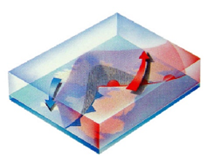
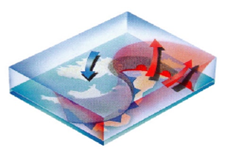
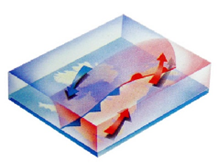
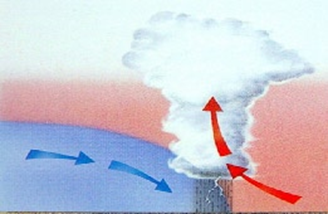
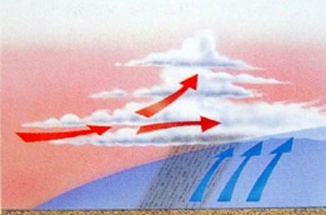
Warm Front Clouds – Warmer air slowly penetrates into an area of colder air and must rise; layered clouds form, usually associated with a continuous band of precipitation.
Cold front cloudiness – Cold air penetrates rapidly into an area of warm air and pushes it upward; cumulus clouds form, often accompanied by thunderstorms; precipitation is usually heavy and brief.
The International Cloud Classification uses Latin names and divides clouds into 3 main groups 11Klima skripta. Gisáci na UPOL: GIS GEOINFORMATIKA A ROMANTIKA [online]. Olomouc: MarijaStudio, 2007 [cit. 2017-09-03]. Dostupné z: http://www.gisaci.upol.cz/filesftp/Klima_skripta.pdf.: Cirrus (algae), Stratus (folder) and Cumulus (pile).
From these, 10 basic species have been derived; the International Cloud Atlas is used to pinpoint12Klima skripta. Gisáci na UPOL: GIS GEOINFORMATIKA A ROMANTIKA [online]. Olomouc: MarijaStudio, 2007 [cit. 2017-09-03]. Dostupné z: http://www.gisaci.upol.cz/filesftp/Klima_skripta.pdf.:
Cirrus (Ci) – an alga, of ice crystals, thin filaments or threads, straight, irregularly curved and interconnected.
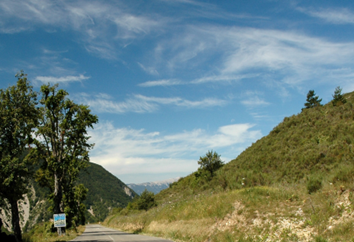
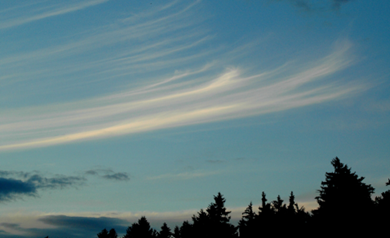
Cirrocumulus (Cc) – algal pile, thin large groups of white clouds, lambs, no shadows,
Cirrostratus (Cs) – algal composition, translucent veil of clouds, fibrous or smooth appearance, complete or partial coverage – hall phenomena.
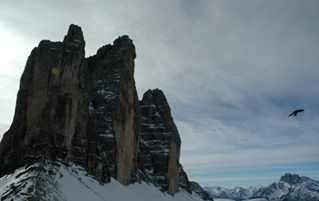
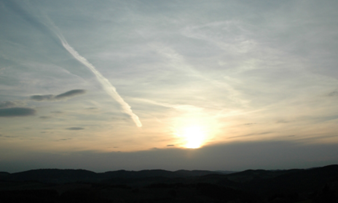
Altocumulus (As) – raised cluster, white and grey clouds with shadows, groups or layers, idea of waves and mounds, see picture – orographic clouds.
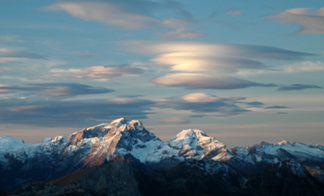
Altostratus (Ac) – high slope, greyish to bluish surface, fibrous to ribbed structure, full or partial coverage, thin but without halo phenomena,
Nimbostratus (Ns) – rainy sky, grey to dark clouds, dull appearance due to rain and snowfall, thick layer, sun not coming through,
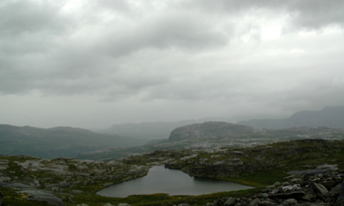
Startocumulus (Sc) – style cluster, grey to whitish groups of clouds, have dark spots,
Stratus (St) – composition, grey, monotonous base, drizzle, ice needles and grains,
Cumulus (Cu) – Cluster, solitary clouds, dense with well-defined outlines, developing upward into towers and clusters, the upper part cauliflower.
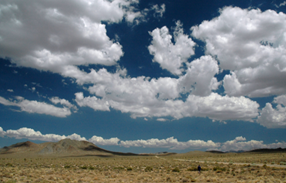
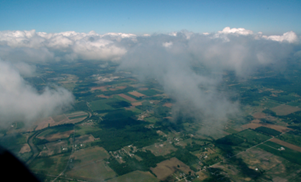
Cumulonimbus (Cb) – storm cloud, massive and dense, the upper part flattened like an anvil, heavy rainfall and dark.
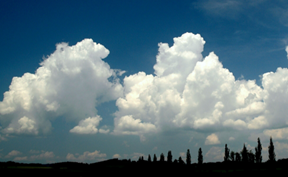

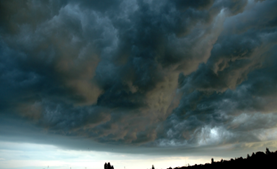
Further breakdown by source13Klima skripta. Gisáci na UPOL: GIS GEOINFORMATIKA A ROMANTIKA [online]. Olomouc: MarijaStudio, 2007 [cit. 2017-09-03]. Dostupné z: http://www.gisaci.upol.cz/filesftp/Klima_skripta.pdf.:
High clouds – Ci, Cc, Cs – base h = 5-13 km, made of ice crystals, white and translucent.
Medium clouds – As, Ac – h = 2-7 km
Low clouds – Ns, St, Cu, Sc – grey and precipitation, up to 2 km
Clouds with vertical development – Cu,Cb – storm clouds, hail.
Clouds from convection – they are formed inside air masses or on the front. In highly unstable air masses.
Wave clouds – Sc, Ac
Clouds from outward movements, clouds from emanations.
Strange: pearly clouds (supercooled droplets), night glowing clouds (cosmic dust), condensation streaks (airplanes), clouds from fires, volcanic clouds.
Clouds cause the surface of the Earth to cool – not as much radiation reaches the surface. Clouds greatly affect the climate. Synoptic meteorology – eighths, climatology tenths14Klima skripta. Gisáci na UPOL: GIS GEOINFORMATIKA A ROMANTIKA [online]. Olomouc: MarijaStudio, 2007 [cit. 2017-09-03]. Dostupné z: http://www.gisaci.upol.cz/filesftp/Klima_skripta.pdf..
Optical phenomena in the atmosphere – photometeors by:
Hall effects – reflection and refraction of sunlight on ice crystals scattered in the air. These are bright, whitish, faintly iridescent streaks, arcs or wheels in the sky. A distinction is made between a small halo (very common) and a large halo (less common) with the Sun always at the centre. Very rare is also the secondary sun – 1/year, then the halo column, the cirrus arc, the counter-sun15Klima skripta. Gisáci na UPOL: GIS GEOINFORMATIKA A ROMANTIKA [online]. Olomouc: MarijaStudio, 2007 [cit. 2017-09-03]. Dostupné z: http://www.gisaci.upol.cz/filesftp/Klima_skripta.pdf..
Gloriola and corona – in thin water clouds we observe small circles (wreaths) in front of the sun and moon = corona. The corona is the result of the bending of light on the cloud particles Ac, Cc, Cs. These rings are bluish to reddish. They are sometimes called a halo16Klima skripta. Gisáci na UPOL: GIS GEOINFORMATIKA A ROMANTIKA [online]. Olomouc: MarijaStudio, 2007 [cit. 2017-09-03]. Dostupné z: http://www.gisaci.upol.cz/filesftp/Klima_skripta.pdf..
The colored circles around the shadows of objects on the clouds are called gloriola17Klima skripta. Gisáci na UPOL: GIS GEOINFORMATIKA A ROMANTIKA [online]. Olomouc: MarijaStudio, 2007 [cit. 2017-09-03]. Dostupné z: http://www.gisaci.upol.cz/filesftp/Klima_skripta.pdf..
A rainbow – probably the most famous optical phenomenon – the refraction of light as the beam passes through layers of air with more water droplets. The inside is purple, the outside is red18Klima skripta. Gisáci na UPOL: GIS GEOINFORMATIKA A ROMANTIKA [online]. Olomouc: MarijaStudio, 2007 [cit. 2017-09-03]. Dostupné z: http://www.gisaci.upol.cz/filesftp/Klima_skripta.pdf..
Twilight phenomena – after sunset or before sunrise, part of the sky is illuminated by diffuse sunlight, unless it is prevented by the complete coverage of the sky by dense clouds. Some optical phenomena can be observed when this happens, which are caused by refraction, scattering and absorption of sunlight in the atmosphere19NEČAS, Tomáš. Fyzika v atmosféře aneb základy meteorologie: Modulární systém dalšího vzdělávání pedagogických pracovníků JmK v přírodních vědách a informatice CZ.1.07/1.3.10/02.0024. Brno: Přírodovědecká fakulta, Masarykova univerzita v Brně, 2011. Dostupné z: http://ucitele.sci.muni.cz/materialy/94_1.pdf: violet glow, green ray, apparent enlargement of the sun’s or moon’s disk, others.
Optical phenomena in the atmosphere – other by source 20SKŘEHOT, Petr. Atmosférické optické jevy. Meteorologická Optická Rada. [Online 3. 9. 2017]. Dostupné z: www.astronomie.cz/download/atmosfericke-opticke-jevy.pdf:
Lightning – line, branched, spherical or area lightning – Lightning is the discharge of atmospheric electricity produced during thunderstorms that accompanies thunder. Thunderstorms are distinguished according to their origin into frontal and local thunderstorms – originating from heat. The discharges of atmospheric electricity can take place within storm clouds or between clouds, or between a cloud and the ground, which acts as a positively charged capacitor. In all three cases, the discharge occurs between differently charged regions in the form of a fast-moving flash.
Elijah’s Fire – during thunderstorms, charge can build up on spikes and elevated metal objects and atmospheric electricity can be discharged. Strong spike discharges are also accompanied by sound effects (crackling) and sometimes clearly visible visual sensations consisting of sparks and sizzling.
Auroras – have a rayed or unrayshaped structure. In the first case, they are usually fast-moving light phenomena in the form of coloured rays, curtains, draperies, etc. The second type is usually observed in the form of non-moving or only slightly moving arcs, or only diffuse light. Aurorae are most often found in the regions around the Earth’s magnetic poles, the greatest frequency of their occurrence being approximately along a circle drawn across the globe at an angular distance of about 20-25° from the said poles. Auroras are produced by the interaction of electrically charged particles with molecules of highly diluted air, i.e. at altitudes between 80 and 1000 km above the Earth’s surface.
Tyndall effect – is based on diffuse scattering of light passing through an optically heterogeneous system, manifested by the fact that the path of the beam passing through the dispersion, observed perpendicular to its direction, is visible. Of the white light, radiation of shorter wavelengths is scattered the most, and the scattered light then carries a blue-white tinge.
Bishop’s circle – a reddish-brown ring around the Sun, with an inner edge of about 10° and an outer edge of about 20°. Both radii increase as the Sun’s height above the horizon decreases. It is formed by the bending of light on solid particles, usually of volcanic origin.
Meteors – shining bright lines of light. It is caused by a small body, usually on the order of micrometres to millimetres in size, orbiting the Sun in an elliptical path at speeds of kilometres per second. When the body accidentally encounters the Earth, it enters our atmosphere and, as it passes through the atmosphere, heats up strongly and excites the surrounding air particles to radiate. As the body passes through the atmosphere, the surface layers or the whole body are melted by the friction of the body against the air molecules.
Atmospheric precipitation
Atmospheric precipitation is particles formed in the atmosphere by condensation of water vapour that occur in the atmosphere, on the Earth’s surface, or on objects in liquid or solid form 21Klima skripta. Gisáci na UPOL: GIS GEOINFORMATIKA A ROMANTIKA [online]. Olomouc: MarijaStudio, 2007 [cit. 2017-09-03]. Dostupné z: http://www.gisaci.upol.cz/filesftp/Klima_skripta.pdf..
Vertical precipitation is that which falls from clouds. The most familiar forms are rain and snow. Precipitation of a permanent nature falls most often from clouds of outflow slip Ns, As. Storm clouds Cb usually bring only showery precipitation. In addition to sustained precipitation, we also observe drizzle – typical of warm and stable air masses and clouds St, Sc. Vertical precipitation by source22Klima skripta. Gisáci na UPOL: GIS GEOINFORMATIKA A ROMANTIKA [online]. Olomouc: MarijaStudio, 2007 [cit. 2017-09-03]. Dostupné z: http://www.gisaci.upol.cz/filesftp/Klima_skripta.pdf.:
Rain – water precipitation, in the form of drops, from 0.5 to 7.0 mm in diameter; we speak of rain even if the drops are smaller than 0.5 mm but fall thickly.
Drizzle – tiny droplets up to 0.5 mm in diameter, but not of sufficient intensity to be considered rain.
Snow – solid precipitation consisting of ice crystals or clusters of various shapes. The basic shape is a six-pointed plate – a flake. At higher temperatures they are clumps, at temperatures below -5°C they are smaller flakes.
Snowflakes – solid precipitation, composed of white opaque ice particles, falling in showers around the freezing point, 2-5 mm in diameter, shattering on impact.
Snow grains – solid precipitation, they are made of ice and are smaller than snowflakes, less than 1 mm. They do not shatter on impact. At temperatures below freezing and resemble drizzle.
Frost flakes – snow grains coated with a layer of ice, approx. 5 mm in diameter, at temperatures around the freezing point, accompany rain, bounce and shatter.
Frozen rain – falling transparent, semi-transparent ice grains with a diameter of 5 mm, formed by freezing raindrops, sometimes with water inside.
Hail – balls, pieces or fragments of ice 5-50 mm, weighing up to 0.5 kg.
Ice needles – simple ice crystals in the shape of needles, floating or falling very slowly. Typical for polar regions, here only during heavy frosts.
Settled (horizontal) precipitation – when the condensation process took place on the earth’s surface or on objects on it (buildings, trees, power lines,…):
Dew – deposition of water in the form of small droplets, on the ground surface, plants, or various objects. The formation is related to radiative cooling, when the temperature drops below the dew point. Most often in the evening or at night in the warm half of the year. In extremes of 10-30 mm per year. In continental climates it is an addition to the rainfall.
Frozen dew – frozen dew drops.
Dew – crystalline deposits similar to dew but always below freezing, icy flakes and needles with a fine texture, on grass and horizontal surfaces but not on trees and wires.
Jinovatka – fine needles, clusters with clear crystalline texture, settles in heavy frosts on trees and el. Frost can cause heavy frost in heavy frost, when the frost is strong, it can damage power lines.
Fogging – water droplets on windward positions.
Frost – white transparent granular deposit composed of snow-white clusters on windward facing objects. It forms in fog at temperatures from -2 to -10°C on the ground, objects, trees, power lines, aircraft in flight.
Frost – a continuous transparent deposit of ice, frozen droplets in rain or drizzle.
Icing and freezing – freezing of droplets after they hit the ground.
Inversion
Inversion the term refers to a particular abnormal vertical distribution of air temperature. In a particular “inversion” layer, the air temperature increases with increasing height. It usually affects the not-so-powerful layers of the troposphere. They are characterized by the height (ground and high) at which they occur, the power (upper and lower boundaries of the inversion), the temperature difference and the temperature gradient. If an inversion occurs in several layers above each other – a mixed inversion. According to the cause of the inversion we divide: advective, frontal, radiative, subsidence, turbulent and trade winds.23Klima skripta. Gisáci na UPOL: GIS GEOINFORMATIKA A ROMANTIKA [online]. Olomouc: MarijaStudio, 2007 [cit. 2017-09-03]. Dostupné z: http://www.gisaci.upol.cz/filesftp/Klima_skripta.pdf..
